Health and Safety in Health and Social Care - Semester 1 Assignment
VerifiedAdded on 2020/05/08
|14
|2802
|162
Homework Assignment
AI Summary
This assignment provides a comprehensive overview of health and safety in health and social care settings. It identifies relevant legislation, including the Management of Health and Safety at Work Regulations, the Health and Safety at Work Act 1974, COSHH, RIDDOR, and PPE regulations. The assignment explains key health and safety policies and procedures, analyzes the responsibilities of self, employers/managers, and other healthcare workers, and identifies tasks requiring special training. It details the use of policies and procedures in the workplace, methods for supporting others in safe practices, and procedures for monitoring and reporting risks, including the role of risk assessment. Furthermore, the assignment explores different types of accidents and illnesses, outlines emergency procedures, explains the role in infection control, and covers legislation and principles related to moving and handling. It also describes hazardous substances, fire prevention practices, and emergency fire procedures. Overall, the assignment showcases a strong understanding of health and safety principles and their practical application in healthcare environments.
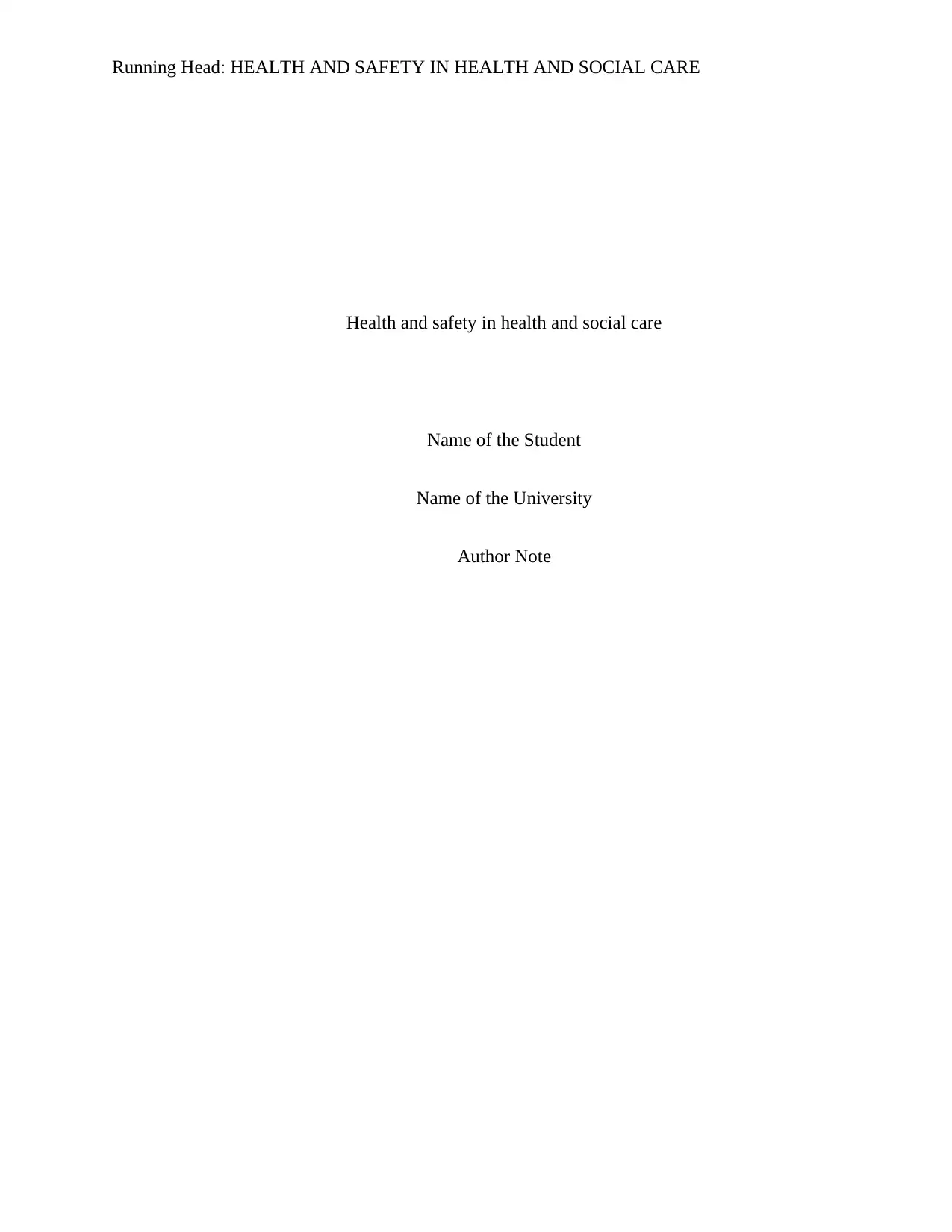
Running Head: HEALTH AND SAFETY IN HEALTH AND SOCIAL CARE
Health and safety in health and social care
Name of the Student
Name of the University
Author Note
Health and safety in health and social care
Name of the Student
Name of the University
Author Note
Paraphrase This Document
Need a fresh take? Get an instant paraphrase of this document with our AI Paraphraser
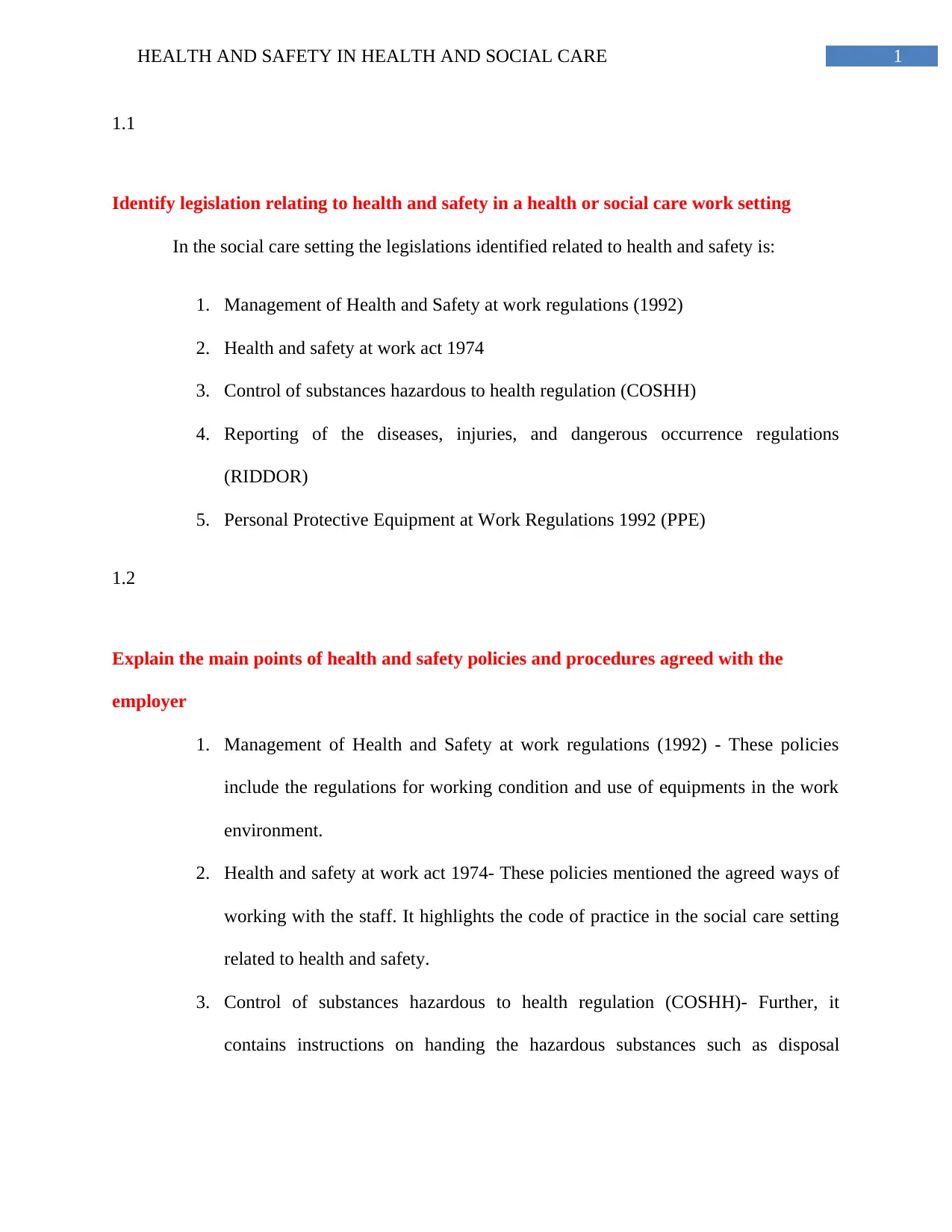
1HEALTH AND SAFETY IN HEALTH AND SOCIAL CARE
1.1
Identify legislation relating to health and safety in a health or social care work setting
In the social care setting the legislations identified related to health and safety is:
1. Management of Health and Safety at work regulations (1992)
2. Health and safety at work act 1974
3. Control of substances hazardous to health regulation (COSHH)
4. Reporting of the diseases, injuries, and dangerous occurrence regulations
(RIDDOR)
5. Personal Protective Equipment at Work Regulations 1992 (PPE)
1.2
Explain the main points of health and safety policies and procedures agreed with the
employer
1. Management of Health and Safety at work regulations (1992) - These policies
include the regulations for working condition and use of equipments in the work
environment.
2. Health and safety at work act 1974- These policies mentioned the agreed ways of
working with the staff. It highlights the code of practice in the social care setting
related to health and safety.
3. Control of substances hazardous to health regulation (COSHH)- Further, it
contains instructions on handing the hazardous substances such as disposal
1.1
Identify legislation relating to health and safety in a health or social care work setting
In the social care setting the legislations identified related to health and safety is:
1. Management of Health and Safety at work regulations (1992)
2. Health and safety at work act 1974
3. Control of substances hazardous to health regulation (COSHH)
4. Reporting of the diseases, injuries, and dangerous occurrence regulations
(RIDDOR)
5. Personal Protective Equipment at Work Regulations 1992 (PPE)
1.2
Explain the main points of health and safety policies and procedures agreed with the
employer
1. Management of Health and Safety at work regulations (1992) - These policies
include the regulations for working condition and use of equipments in the work
environment.
2. Health and safety at work act 1974- These policies mentioned the agreed ways of
working with the staff. It highlights the code of practice in the social care setting
related to health and safety.
3. Control of substances hazardous to health regulation (COSHH)- Further, it
contains instructions on handing the hazardous substances such as disposal
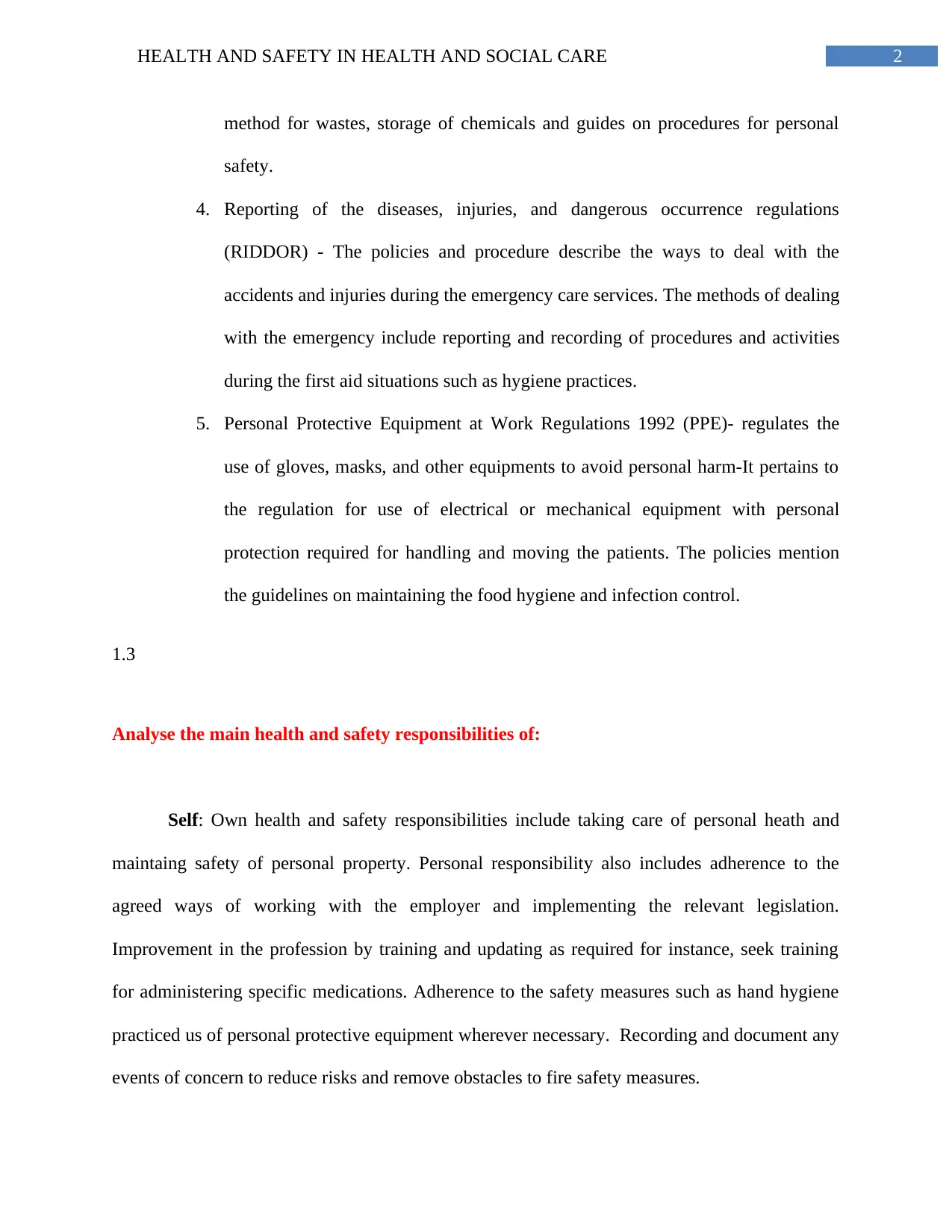
2HEALTH AND SAFETY IN HEALTH AND SOCIAL CARE
method for wastes, storage of chemicals and guides on procedures for personal
safety.
4. Reporting of the diseases, injuries, and dangerous occurrence regulations
(RIDDOR) - The policies and procedure describe the ways to deal with the
accidents and injuries during the emergency care services. The methods of dealing
with the emergency include reporting and recording of procedures and activities
during the first aid situations such as hygiene practices.
5. Personal Protective Equipment at Work Regulations 1992 (PPE)- regulates the
use of gloves, masks, and other equipments to avoid personal harm-It pertains to
the regulation for use of electrical or mechanical equipment with personal
protection required for handling and moving the patients. The policies mention
the guidelines on maintaining the food hygiene and infection control.
1.3
Analyse the main health and safety responsibilities of:
Self: Own health and safety responsibilities include taking care of personal heath and
maintaing safety of personal property. Personal responsibility also includes adherence to the
agreed ways of working with the employer and implementing the relevant legislation.
Improvement in the profession by training and updating as required for instance, seek training
for administering specific medications. Adherence to the safety measures such as hand hygiene
practiced us of personal protective equipment wherever necessary. Recording and document any
events of concern to reduce risks and remove obstacles to fire safety measures.
method for wastes, storage of chemicals and guides on procedures for personal
safety.
4. Reporting of the diseases, injuries, and dangerous occurrence regulations
(RIDDOR) - The policies and procedure describe the ways to deal with the
accidents and injuries during the emergency care services. The methods of dealing
with the emergency include reporting and recording of procedures and activities
during the first aid situations such as hygiene practices.
5. Personal Protective Equipment at Work Regulations 1992 (PPE)- regulates the
use of gloves, masks, and other equipments to avoid personal harm-It pertains to
the regulation for use of electrical or mechanical equipment with personal
protection required for handling and moving the patients. The policies mention
the guidelines on maintaining the food hygiene and infection control.
1.3
Analyse the main health and safety responsibilities of:
Self: Own health and safety responsibilities include taking care of personal heath and
maintaing safety of personal property. Personal responsibility also includes adherence to the
agreed ways of working with the employer and implementing the relevant legislation.
Improvement in the profession by training and updating as required for instance, seek training
for administering specific medications. Adherence to the safety measures such as hand hygiene
practiced us of personal protective equipment wherever necessary. Recording and document any
events of concern to reduce risks and remove obstacles to fire safety measures.
⊘ This is a preview!⊘
Do you want full access?
Subscribe today to unlock all pages.

Trusted by 1+ million students worldwide
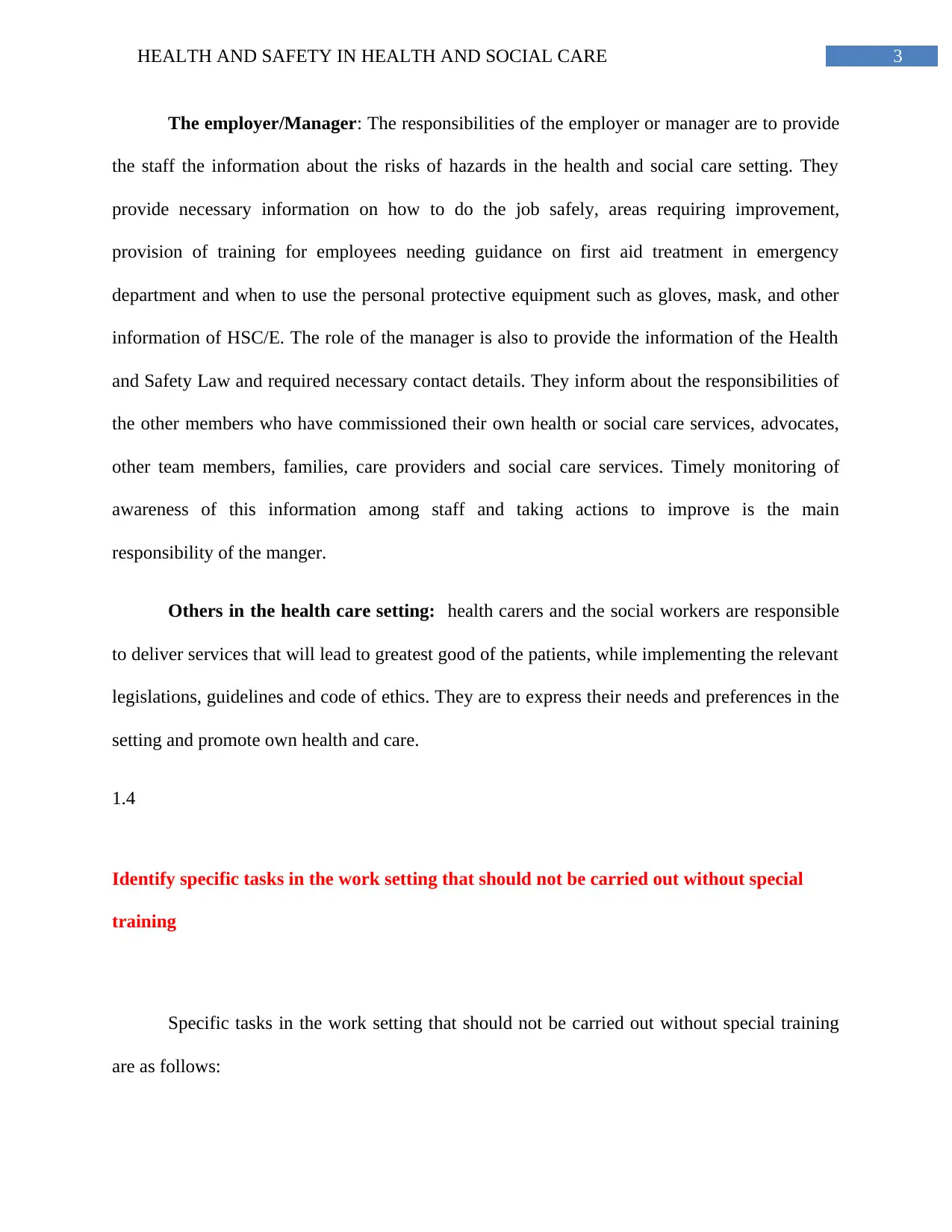
3HEALTH AND SAFETY IN HEALTH AND SOCIAL CARE
The employer/Manager: The responsibilities of the employer or manager are to provide
the staff the information about the risks of hazards in the health and social care setting. They
provide necessary information on how to do the job safely, areas requiring improvement,
provision of training for employees needing guidance on first aid treatment in emergency
department and when to use the personal protective equipment such as gloves, mask, and other
information of HSC/E. The role of the manager is also to provide the information of the Health
and Safety Law and required necessary contact details. They inform about the responsibilities of
the other members who have commissioned their own health or social care services, advocates,
other team members, families, care providers and social care services. Timely monitoring of
awareness of this information among staff and taking actions to improve is the main
responsibility of the manger.
Others in the health care setting: health carers and the social workers are responsible
to deliver services that will lead to greatest good of the patients, while implementing the relevant
legislations, guidelines and code of ethics. They are to express their needs and preferences in the
setting and promote own health and care.
1.4
Identify specific tasks in the work setting that should not be carried out without special
training
Specific tasks in the work setting that should not be carried out without special training
are as follows:
The employer/Manager: The responsibilities of the employer or manager are to provide
the staff the information about the risks of hazards in the health and social care setting. They
provide necessary information on how to do the job safely, areas requiring improvement,
provision of training for employees needing guidance on first aid treatment in emergency
department and when to use the personal protective equipment such as gloves, mask, and other
information of HSC/E. The role of the manager is also to provide the information of the Health
and Safety Law and required necessary contact details. They inform about the responsibilities of
the other members who have commissioned their own health or social care services, advocates,
other team members, families, care providers and social care services. Timely monitoring of
awareness of this information among staff and taking actions to improve is the main
responsibility of the manger.
Others in the health care setting: health carers and the social workers are responsible
to deliver services that will lead to greatest good of the patients, while implementing the relevant
legislations, guidelines and code of ethics. They are to express their needs and preferences in the
setting and promote own health and care.
1.4
Identify specific tasks in the work setting that should not be carried out without special
training
Specific tasks in the work setting that should not be carried out without special training
are as follows:
Paraphrase This Document
Need a fresh take? Get an instant paraphrase of this document with our AI Paraphraser
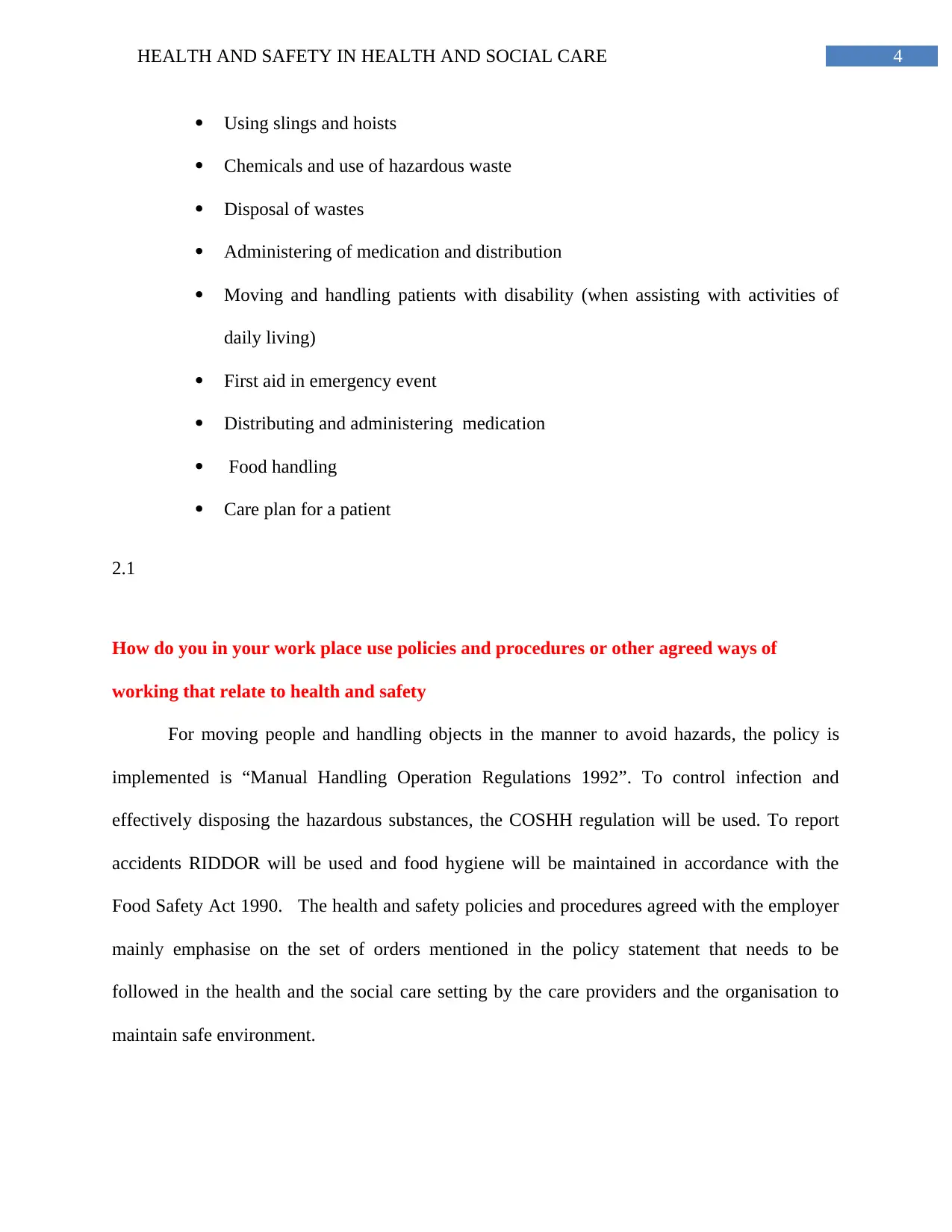
4HEALTH AND SAFETY IN HEALTH AND SOCIAL CARE
Using slings and hoists
Chemicals and use of hazardous waste
Disposal of wastes
Administering of medication and distribution
Moving and handling patients with disability (when assisting with activities of
daily living)
First aid in emergency event
Distributing and administering medication
Food handling
Care plan for a patient
2.1
How do you in your work place use policies and procedures or other agreed ways of
working that relate to health and safety
For moving people and handling objects in the manner to avoid hazards, the policy is
implemented is “Manual Handling Operation Regulations 1992”. To control infection and
effectively disposing the hazardous substances, the COSHH regulation will be used. To report
accidents RIDDOR will be used and food hygiene will be maintained in accordance with the
Food Safety Act 1990. The health and safety policies and procedures agreed with the employer
mainly emphasise on the set of orders mentioned in the policy statement that needs to be
followed in the health and the social care setting by the care providers and the organisation to
maintain safe environment.
Using slings and hoists
Chemicals and use of hazardous waste
Disposal of wastes
Administering of medication and distribution
Moving and handling patients with disability (when assisting with activities of
daily living)
First aid in emergency event
Distributing and administering medication
Food handling
Care plan for a patient
2.1
How do you in your work place use policies and procedures or other agreed ways of
working that relate to health and safety
For moving people and handling objects in the manner to avoid hazards, the policy is
implemented is “Manual Handling Operation Regulations 1992”. To control infection and
effectively disposing the hazardous substances, the COSHH regulation will be used. To report
accidents RIDDOR will be used and food hygiene will be maintained in accordance with the
Food Safety Act 1990. The health and safety policies and procedures agreed with the employer
mainly emphasise on the set of orders mentioned in the policy statement that needs to be
followed in the health and the social care setting by the care providers and the organisation to
maintain safe environment.
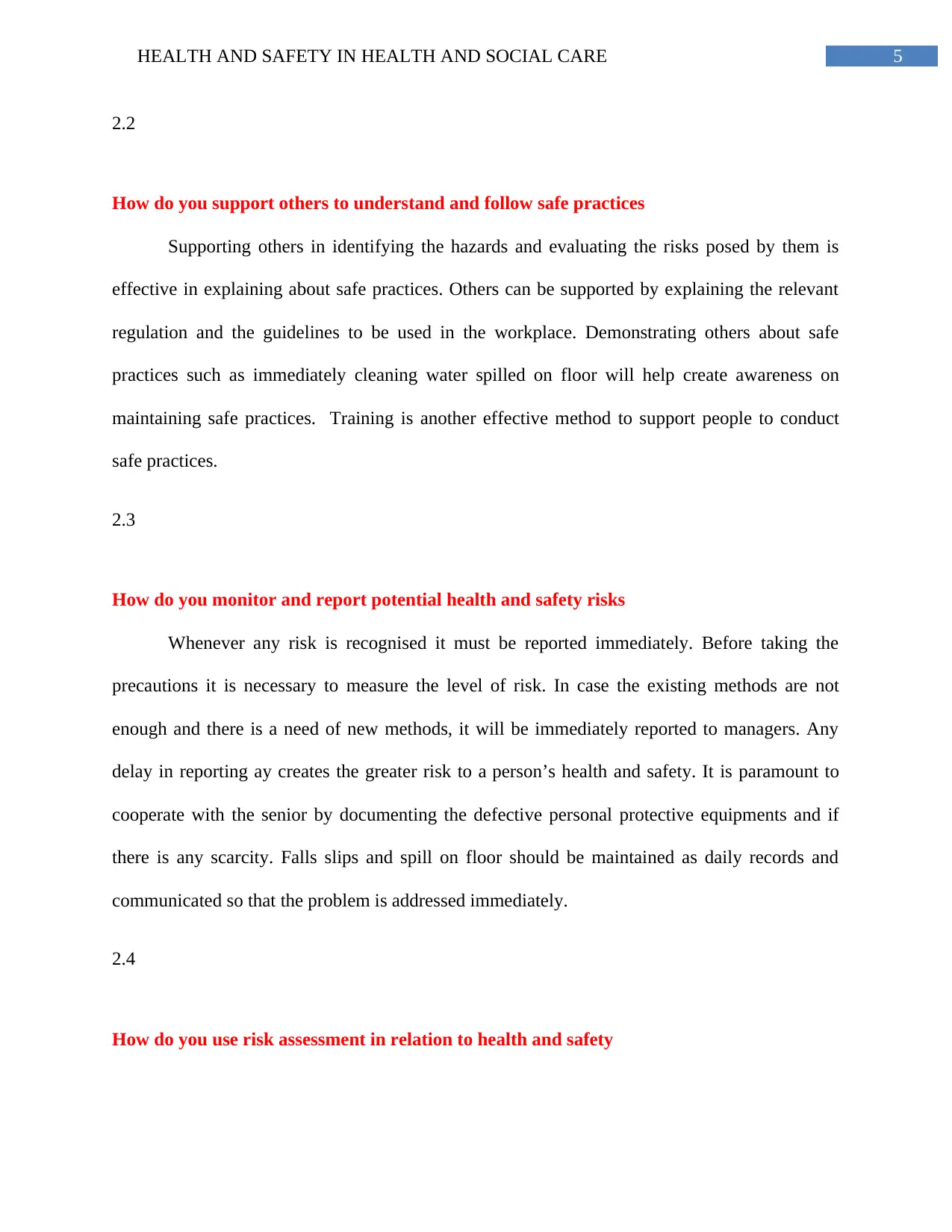
5HEALTH AND SAFETY IN HEALTH AND SOCIAL CARE
2.2
How do you support others to understand and follow safe practices
Supporting others in identifying the hazards and evaluating the risks posed by them is
effective in explaining about safe practices. Others can be supported by explaining the relevant
regulation and the guidelines to be used in the workplace. Demonstrating others about safe
practices such as immediately cleaning water spilled on floor will help create awareness on
maintaining safe practices. Training is another effective method to support people to conduct
safe practices.
2.3
How do you monitor and report potential health and safety risks
Whenever any risk is recognised it must be reported immediately. Before taking the
precautions it is necessary to measure the level of risk. In case the existing methods are not
enough and there is a need of new methods, it will be immediately reported to managers. Any
delay in reporting ay creates the greater risk to a person’s health and safety. It is paramount to
cooperate with the senior by documenting the defective personal protective equipments and if
there is any scarcity. Falls slips and spill on floor should be maintained as daily records and
communicated so that the problem is addressed immediately.
2.4
How do you use risk assessment in relation to health and safety
2.2
How do you support others to understand and follow safe practices
Supporting others in identifying the hazards and evaluating the risks posed by them is
effective in explaining about safe practices. Others can be supported by explaining the relevant
regulation and the guidelines to be used in the workplace. Demonstrating others about safe
practices such as immediately cleaning water spilled on floor will help create awareness on
maintaining safe practices. Training is another effective method to support people to conduct
safe practices.
2.3
How do you monitor and report potential health and safety risks
Whenever any risk is recognised it must be reported immediately. Before taking the
precautions it is necessary to measure the level of risk. In case the existing methods are not
enough and there is a need of new methods, it will be immediately reported to managers. Any
delay in reporting ay creates the greater risk to a person’s health and safety. It is paramount to
cooperate with the senior by documenting the defective personal protective equipments and if
there is any scarcity. Falls slips and spill on floor should be maintained as daily records and
communicated so that the problem is addressed immediately.
2.4
How do you use risk assessment in relation to health and safety
⊘ This is a preview!⊘
Do you want full access?
Subscribe today to unlock all pages.

Trusted by 1+ million students worldwide
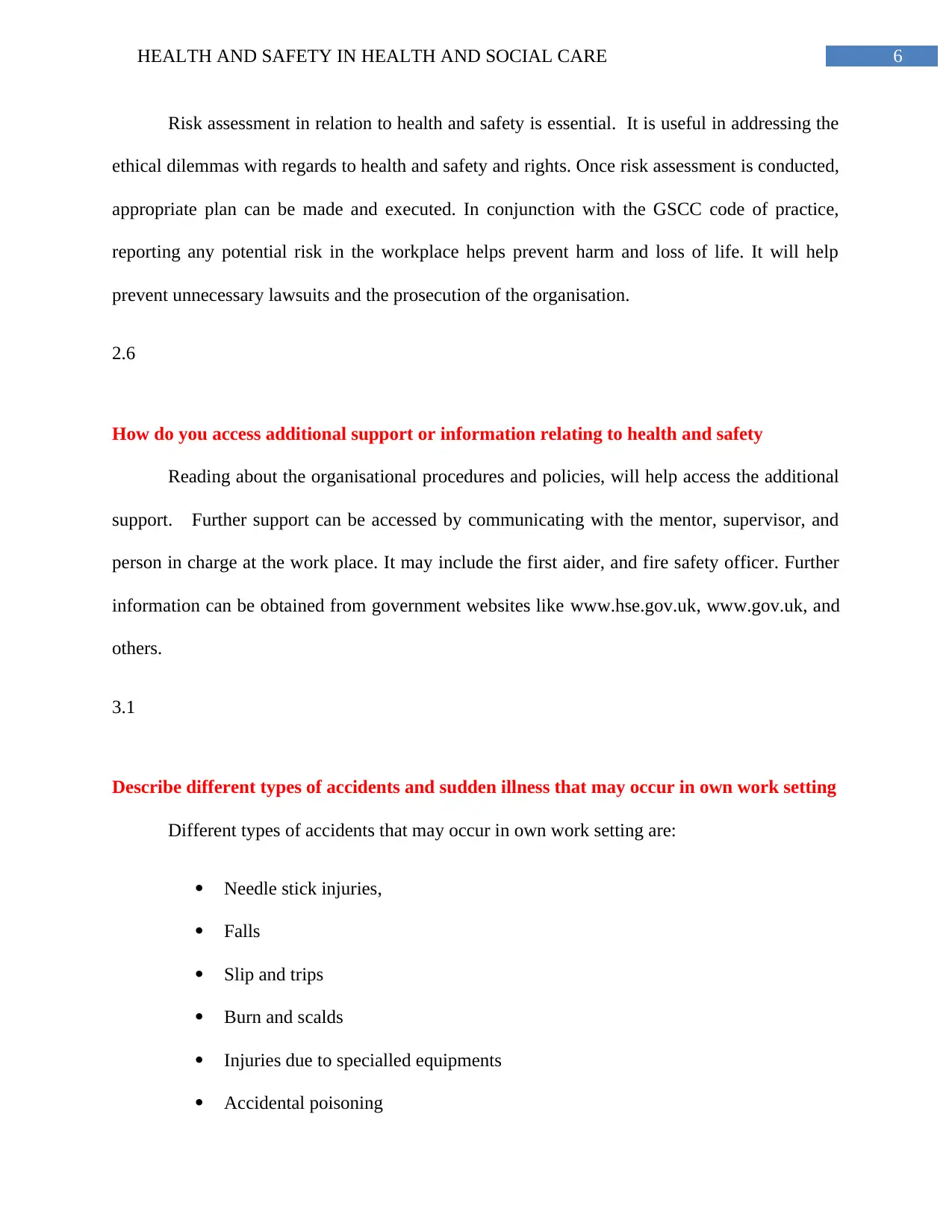
6HEALTH AND SAFETY IN HEALTH AND SOCIAL CARE
Risk assessment in relation to health and safety is essential. It is useful in addressing the
ethical dilemmas with regards to health and safety and rights. Once risk assessment is conducted,
appropriate plan can be made and executed. In conjunction with the GSCC code of practice,
reporting any potential risk in the workplace helps prevent harm and loss of life. It will help
prevent unnecessary lawsuits and the prosecution of the organisation.
2.6
How do you access additional support or information relating to health and safety
Reading about the organisational procedures and policies, will help access the additional
support. Further support can be accessed by communicating with the mentor, supervisor, and
person in charge at the work place. It may include the first aider, and fire safety officer. Further
information can be obtained from government websites like www.hse.gov.uk, www.gov.uk, and
others.
3.1
Describe different types of accidents and sudden illness that may occur in own work setting
Different types of accidents that may occur in own work setting are:
Needle stick injuries,
Falls
Slip and trips
Burn and scalds
Injuries due to specialled equipments
Accidental poisoning
Risk assessment in relation to health and safety is essential. It is useful in addressing the
ethical dilemmas with regards to health and safety and rights. Once risk assessment is conducted,
appropriate plan can be made and executed. In conjunction with the GSCC code of practice,
reporting any potential risk in the workplace helps prevent harm and loss of life. It will help
prevent unnecessary lawsuits and the prosecution of the organisation.
2.6
How do you access additional support or information relating to health and safety
Reading about the organisational procedures and policies, will help access the additional
support. Further support can be accessed by communicating with the mentor, supervisor, and
person in charge at the work place. It may include the first aider, and fire safety officer. Further
information can be obtained from government websites like www.hse.gov.uk, www.gov.uk, and
others.
3.1
Describe different types of accidents and sudden illness that may occur in own work setting
Different types of accidents that may occur in own work setting are:
Needle stick injuries,
Falls
Slip and trips
Burn and scalds
Injuries due to specialled equipments
Accidental poisoning
Paraphrase This Document
Need a fresh take? Get an instant paraphrase of this document with our AI Paraphraser
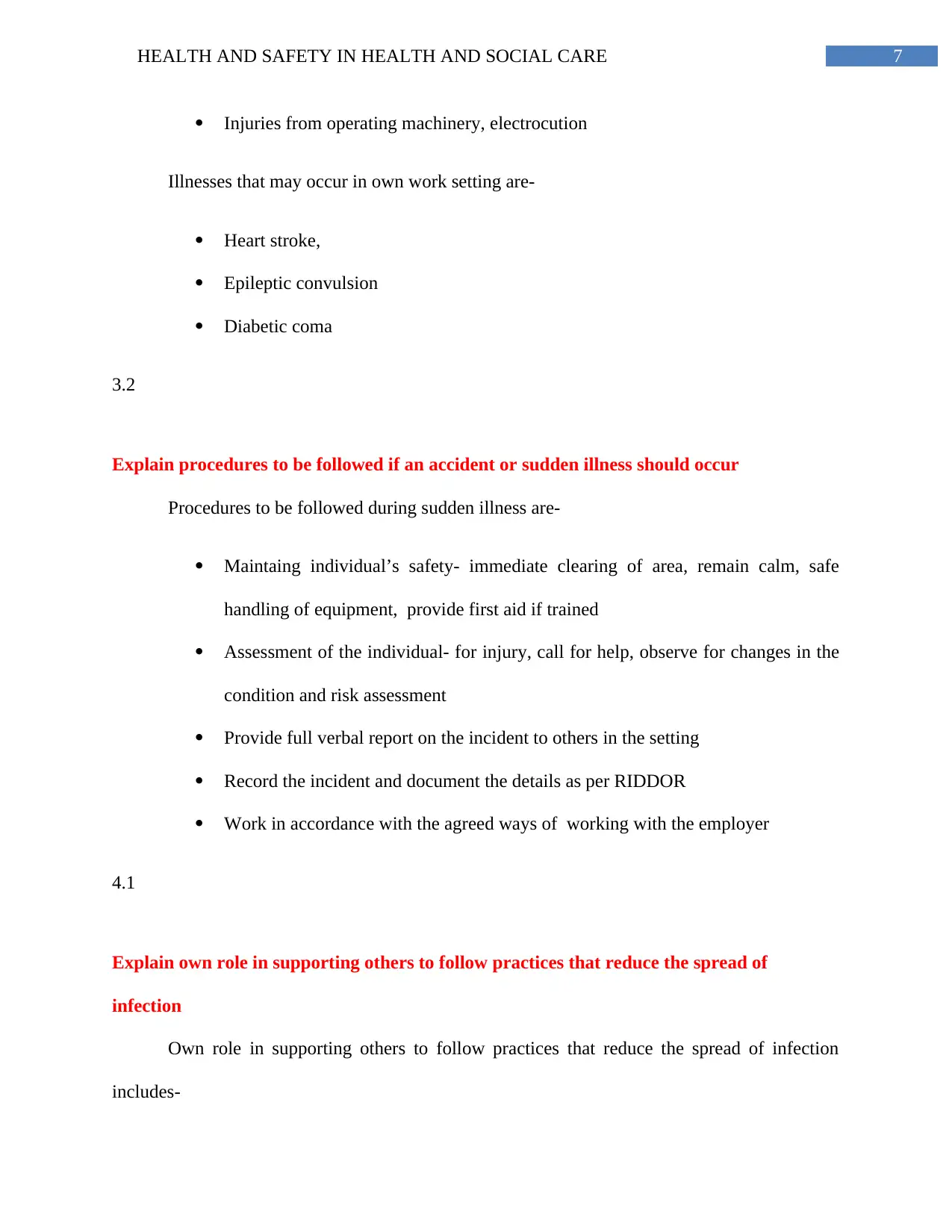
7HEALTH AND SAFETY IN HEALTH AND SOCIAL CARE
Injuries from operating machinery, electrocution
Illnesses that may occur in own work setting are-
Heart stroke,
Epileptic convulsion
Diabetic coma
3.2
Explain procedures to be followed if an accident or sudden illness should occur
Procedures to be followed during sudden illness are-
Maintaing individual’s safety- immediate clearing of area, remain calm, safe
handling of equipment, provide first aid if trained
Assessment of the individual- for injury, call for help, observe for changes in the
condition and risk assessment
Provide full verbal report on the incident to others in the setting
Record the incident and document the details as per RIDDOR
Work in accordance with the agreed ways of working with the employer
4.1
Explain own role in supporting others to follow practices that reduce the spread of
infection
Own role in supporting others to follow practices that reduce the spread of infection
includes-
Injuries from operating machinery, electrocution
Illnesses that may occur in own work setting are-
Heart stroke,
Epileptic convulsion
Diabetic coma
3.2
Explain procedures to be followed if an accident or sudden illness should occur
Procedures to be followed during sudden illness are-
Maintaing individual’s safety- immediate clearing of area, remain calm, safe
handling of equipment, provide first aid if trained
Assessment of the individual- for injury, call for help, observe for changes in the
condition and risk assessment
Provide full verbal report on the incident to others in the setting
Record the incident and document the details as per RIDDOR
Work in accordance with the agreed ways of working with the employer
4.1
Explain own role in supporting others to follow practices that reduce the spread of
infection
Own role in supporting others to follow practices that reduce the spread of infection
includes-
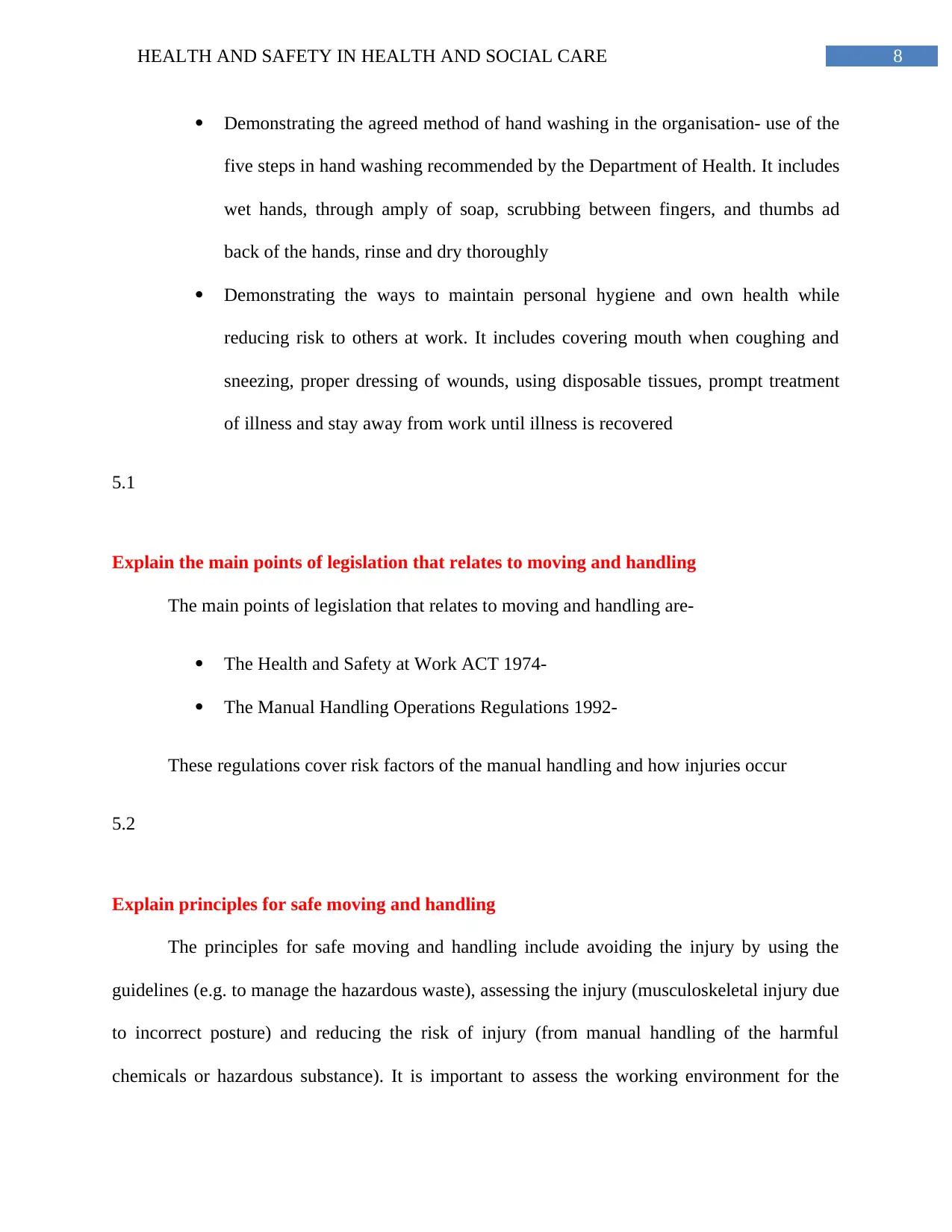
8HEALTH AND SAFETY IN HEALTH AND SOCIAL CARE
Demonstrating the agreed method of hand washing in the organisation- use of the
five steps in hand washing recommended by the Department of Health. It includes
wet hands, through amply of soap, scrubbing between fingers, and thumbs ad
back of the hands, rinse and dry thoroughly
Demonstrating the ways to maintain personal hygiene and own health while
reducing risk to others at work. It includes covering mouth when coughing and
sneezing, proper dressing of wounds, using disposable tissues, prompt treatment
of illness and stay away from work until illness is recovered
5.1
Explain the main points of legislation that relates to moving and handling
The main points of legislation that relates to moving and handling are-
The Health and Safety at Work ACT 1974-
The Manual Handling Operations Regulations 1992-
These regulations cover risk factors of the manual handling and how injuries occur
5.2
Explain principles for safe moving and handling
The principles for safe moving and handling include avoiding the injury by using the
guidelines (e.g. to manage the hazardous waste), assessing the injury (musculoskeletal injury due
to incorrect posture) and reducing the risk of injury (from manual handling of the harmful
chemicals or hazardous substance). It is important to assess the working environment for the
Demonstrating the agreed method of hand washing in the organisation- use of the
five steps in hand washing recommended by the Department of Health. It includes
wet hands, through amply of soap, scrubbing between fingers, and thumbs ad
back of the hands, rinse and dry thoroughly
Demonstrating the ways to maintain personal hygiene and own health while
reducing risk to others at work. It includes covering mouth when coughing and
sneezing, proper dressing of wounds, using disposable tissues, prompt treatment
of illness and stay away from work until illness is recovered
5.1
Explain the main points of legislation that relates to moving and handling
The main points of legislation that relates to moving and handling are-
The Health and Safety at Work ACT 1974-
The Manual Handling Operations Regulations 1992-
These regulations cover risk factors of the manual handling and how injuries occur
5.2
Explain principles for safe moving and handling
The principles for safe moving and handling include avoiding the injury by using the
guidelines (e.g. to manage the hazardous waste), assessing the injury (musculoskeletal injury due
to incorrect posture) and reducing the risk of injury (from manual handling of the harmful
chemicals or hazardous substance). It is important to assess the working environment for the
⊘ This is a preview!⊘
Do you want full access?
Subscribe today to unlock all pages.

Trusted by 1+ million students worldwide
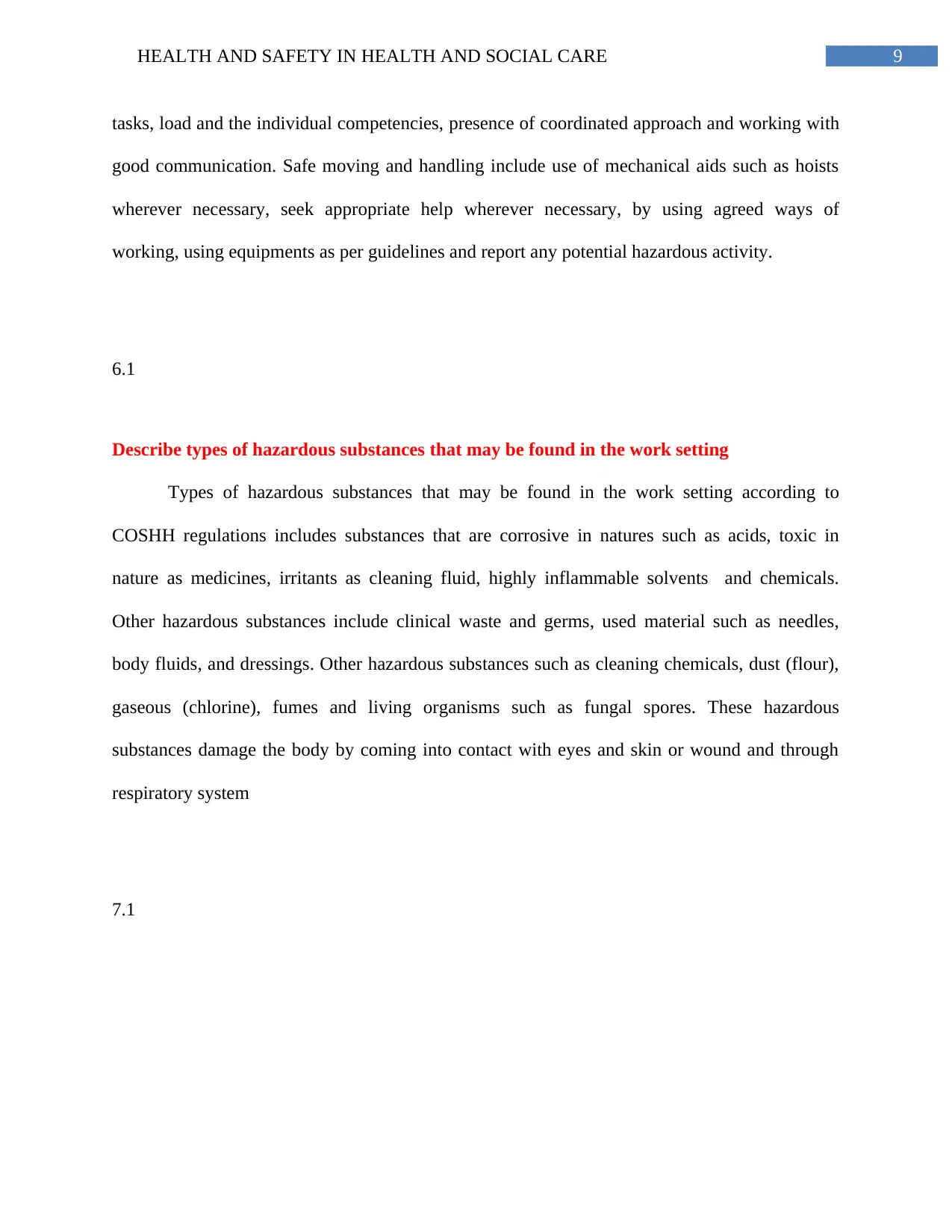
9HEALTH AND SAFETY IN HEALTH AND SOCIAL CARE
tasks, load and the individual competencies, presence of coordinated approach and working with
good communication. Safe moving and handling include use of mechanical aids such as hoists
wherever necessary, seek appropriate help wherever necessary, by using agreed ways of
working, using equipments as per guidelines and report any potential hazardous activity.
6.1
Describe types of hazardous substances that may be found in the work setting
Types of hazardous substances that may be found in the work setting according to
COSHH regulations includes substances that are corrosive in natures such as acids, toxic in
nature as medicines, irritants as cleaning fluid, highly inflammable solvents and chemicals.
Other hazardous substances include clinical waste and germs, used material such as needles,
body fluids, and dressings. Other hazardous substances such as cleaning chemicals, dust (flour),
gaseous (chlorine), fumes and living organisms such as fungal spores. These hazardous
substances damage the body by coming into contact with eyes and skin or wound and through
respiratory system
7.1
tasks, load and the individual competencies, presence of coordinated approach and working with
good communication. Safe moving and handling include use of mechanical aids such as hoists
wherever necessary, seek appropriate help wherever necessary, by using agreed ways of
working, using equipments as per guidelines and report any potential hazardous activity.
6.1
Describe types of hazardous substances that may be found in the work setting
Types of hazardous substances that may be found in the work setting according to
COSHH regulations includes substances that are corrosive in natures such as acids, toxic in
nature as medicines, irritants as cleaning fluid, highly inflammable solvents and chemicals.
Other hazardous substances include clinical waste and germs, used material such as needles,
body fluids, and dressings. Other hazardous substances such as cleaning chemicals, dust (flour),
gaseous (chlorine), fumes and living organisms such as fungal spores. These hazardous
substances damage the body by coming into contact with eyes and skin or wound and through
respiratory system
7.1
Paraphrase This Document
Need a fresh take? Get an instant paraphrase of this document with our AI Paraphraser
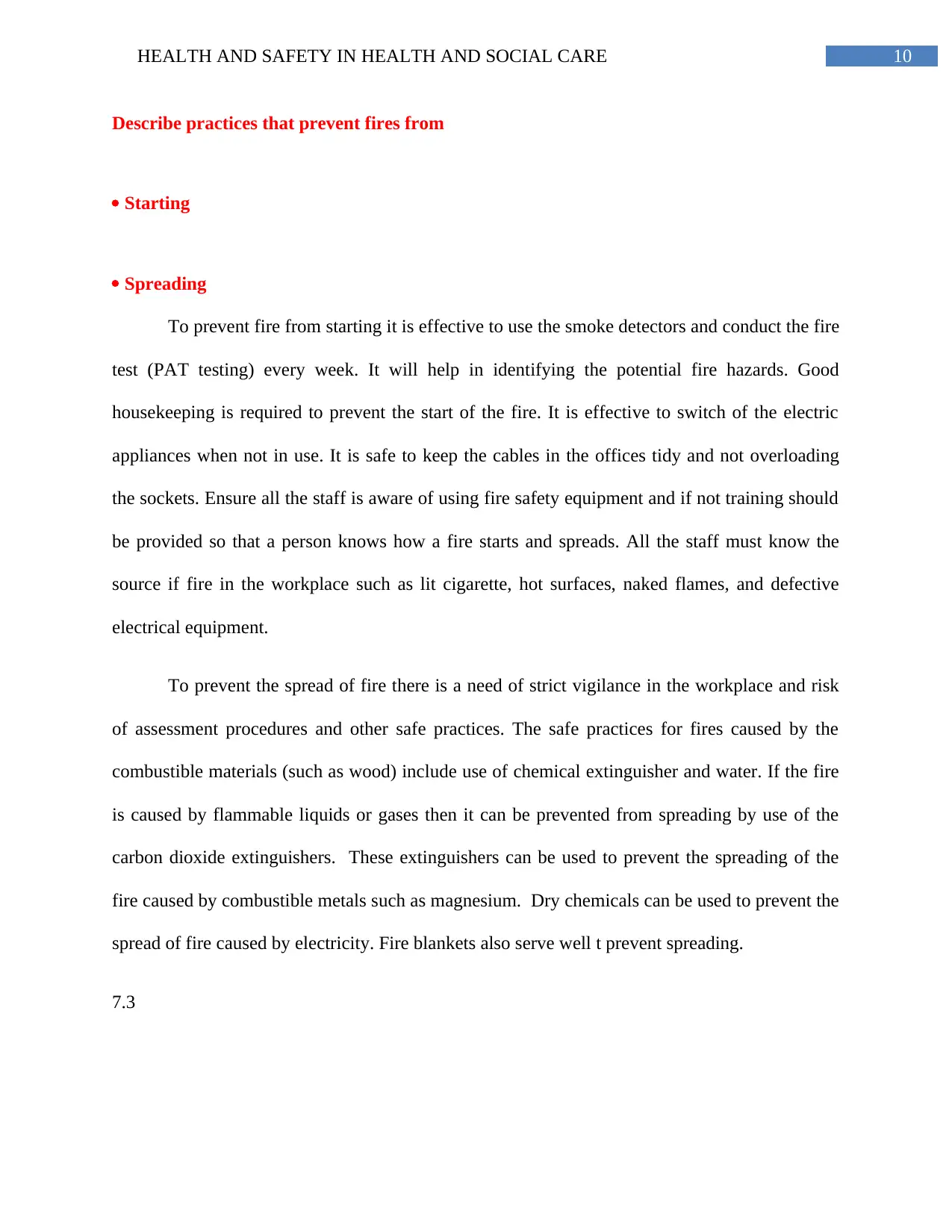
10HEALTH AND SAFETY IN HEALTH AND SOCIAL CARE
Describe practices that prevent fires from
Starting
Spreading
To prevent fire from starting it is effective to use the smoke detectors and conduct the fire
test (PAT testing) every week. It will help in identifying the potential fire hazards. Good
housekeeping is required to prevent the start of the fire. It is effective to switch of the electric
appliances when not in use. It is safe to keep the cables in the offices tidy and not overloading
the sockets. Ensure all the staff is aware of using fire safety equipment and if not training should
be provided so that a person knows how a fire starts and spreads. All the staff must know the
source if fire in the workplace such as lit cigarette, hot surfaces, naked flames, and defective
electrical equipment.
To prevent the spread of fire there is a need of strict vigilance in the workplace and risk
of assessment procedures and other safe practices. The safe practices for fires caused by the
combustible materials (such as wood) include use of chemical extinguisher and water. If the fire
is caused by flammable liquids or gases then it can be prevented from spreading by use of the
carbon dioxide extinguishers. These extinguishers can be used to prevent the spreading of the
fire caused by combustible metals such as magnesium. Dry chemicals can be used to prevent the
spread of fire caused by electricity. Fire blankets also serve well t prevent spreading.
7.3
Describe practices that prevent fires from
Starting
Spreading
To prevent fire from starting it is effective to use the smoke detectors and conduct the fire
test (PAT testing) every week. It will help in identifying the potential fire hazards. Good
housekeeping is required to prevent the start of the fire. It is effective to switch of the electric
appliances when not in use. It is safe to keep the cables in the offices tidy and not overloading
the sockets. Ensure all the staff is aware of using fire safety equipment and if not training should
be provided so that a person knows how a fire starts and spreads. All the staff must know the
source if fire in the workplace such as lit cigarette, hot surfaces, naked flames, and defective
electrical equipment.
To prevent the spread of fire there is a need of strict vigilance in the workplace and risk
of assessment procedures and other safe practices. The safe practices for fires caused by the
combustible materials (such as wood) include use of chemical extinguisher and water. If the fire
is caused by flammable liquids or gases then it can be prevented from spreading by use of the
carbon dioxide extinguishers. These extinguishers can be used to prevent the spreading of the
fire caused by combustible metals such as magnesium. Dry chemicals can be used to prevent the
spread of fire caused by electricity. Fire blankets also serve well t prevent spreading.
7.3
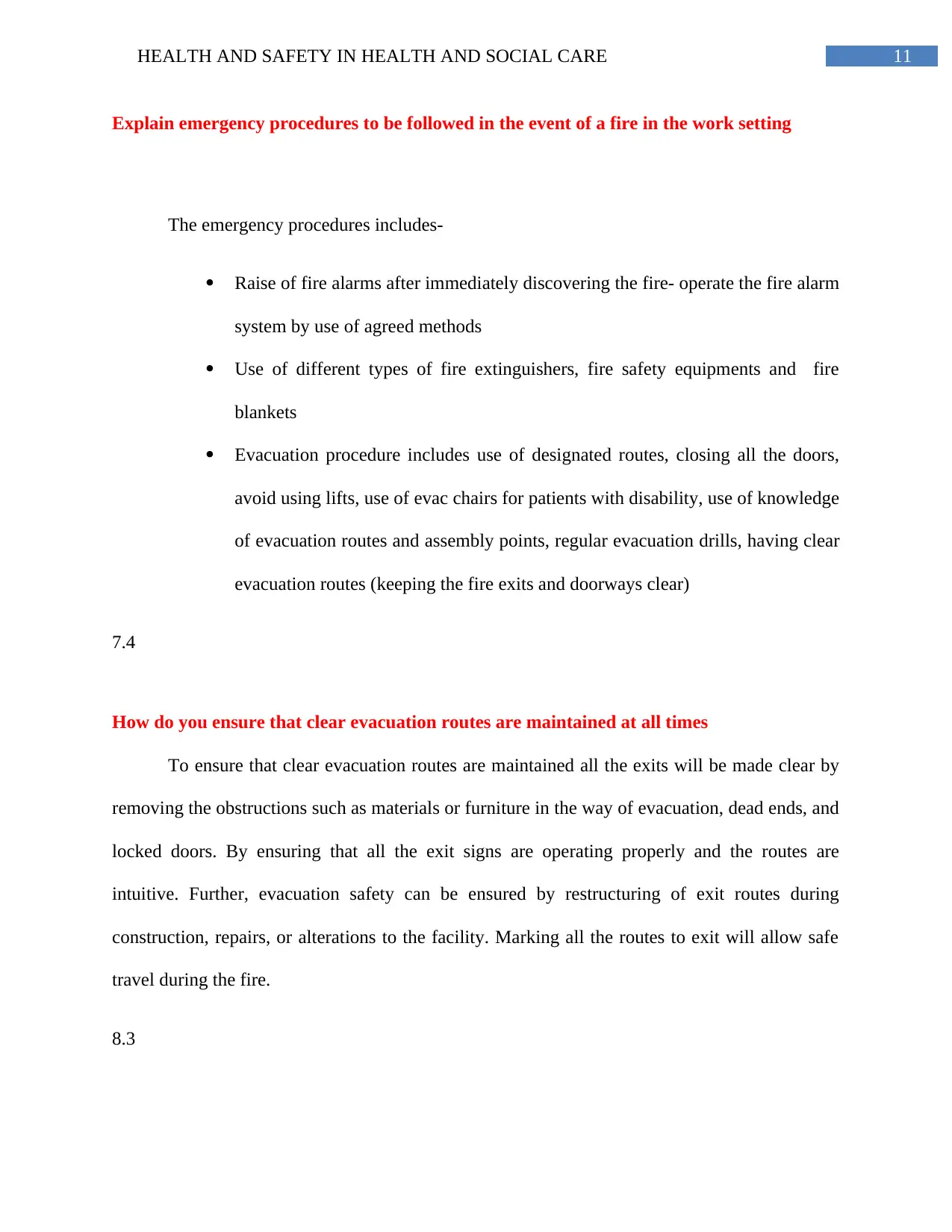
11HEALTH AND SAFETY IN HEALTH AND SOCIAL CARE
Explain emergency procedures to be followed in the event of a fire in the work setting
The emergency procedures includes-
Raise of fire alarms after immediately discovering the fire- operate the fire alarm
system by use of agreed methods
Use of different types of fire extinguishers, fire safety equipments and fire
blankets
Evacuation procedure includes use of designated routes, closing all the doors,
avoid using lifts, use of evac chairs for patients with disability, use of knowledge
of evacuation routes and assembly points, regular evacuation drills, having clear
evacuation routes (keeping the fire exits and doorways clear)
7.4
How do you ensure that clear evacuation routes are maintained at all times
To ensure that clear evacuation routes are maintained all the exits will be made clear by
removing the obstructions such as materials or furniture in the way of evacuation, dead ends, and
locked doors. By ensuring that all the exit signs are operating properly and the routes are
intuitive. Further, evacuation safety can be ensured by restructuring of exit routes during
construction, repairs, or alterations to the facility. Marking all the routes to exit will allow safe
travel during the fire.
8.3
Explain emergency procedures to be followed in the event of a fire in the work setting
The emergency procedures includes-
Raise of fire alarms after immediately discovering the fire- operate the fire alarm
system by use of agreed methods
Use of different types of fire extinguishers, fire safety equipments and fire
blankets
Evacuation procedure includes use of designated routes, closing all the doors,
avoid using lifts, use of evac chairs for patients with disability, use of knowledge
of evacuation routes and assembly points, regular evacuation drills, having clear
evacuation routes (keeping the fire exits and doorways clear)
7.4
How do you ensure that clear evacuation routes are maintained at all times
To ensure that clear evacuation routes are maintained all the exits will be made clear by
removing the obstructions such as materials or furniture in the way of evacuation, dead ends, and
locked doors. By ensuring that all the exit signs are operating properly and the routes are
intuitive. Further, evacuation safety can be ensured by restructuring of exit routes during
construction, repairs, or alterations to the facility. Marking all the routes to exit will allow safe
travel during the fire.
8.3
⊘ This is a preview!⊘
Do you want full access?
Subscribe today to unlock all pages.

Trusted by 1+ million students worldwide
1 out of 14
Related Documents
Your All-in-One AI-Powered Toolkit for Academic Success.
+13062052269
info@desklib.com
Available 24*7 on WhatsApp / Email
![[object Object]](/_next/static/media/star-bottom.7253800d.svg)
Unlock your academic potential
Copyright © 2020–2025 A2Z Services. All Rights Reserved. Developed and managed by ZUCOL.




